Improved Subsidence Assessment for More Reliable Excavation Activity in Tehran
Abstract
:1. Introduction
2. Numerical Modeling
2.1. Creating the Model and Generating the Mesh
2.2. Material Parameters
3. Subsidence Calculation Due to the Excavation Procedure in the Project
4. The Comparison between Excavation Patterns of the NATM
4.1. Comparison of Surface Subsidence between All Patterns
4.2. Comparison of Effective Mean Stresses of All Patterns
5. Conclusions
Author Contributions
Funding
Institutional Review Board Statement
Informed Consent Statement
Data Availability Statement
Conflicts of Interest
References
- Wang, Z.; Sheng, J.; Wang, R.; Li, X.; Xiao, Y.; Yi, Z. Analysis of Microtremor Exploration Application and Construction Monitoring in a Large-Diameter Shield Tunnel. Appl. Sci. 2023, 13, 263. [Google Scholar] [CrossRef]
- Wu, X.; Li, Y.; Gong, M.; Wu, H.; Wu, Y. Deformation and Stress Law of Surrounding Rock for a Bifurcated Tunnel with a Super-Large Section: A Case Study. Appl. Sci. 2023, 13, 12852. [Google Scholar] [CrossRef]
- Zhou, Z.; Zhou, X.; Li, L.; Liu, X.; Wang, L.; Wang, Z. The Construction Methods and Control Mechanisms for Subway Station Undercrossing an Existing Tunnel at Zero Distance. Appl. Sci. 2023, 13, 8826. [Google Scholar] [CrossRef]
- Ranjan, S.S.; Singh, R.K. Analysis of Land subsidence in coastal and urban areas by using various techniques. Indones. J. Geogr. 2023, 55, 488–495. [Google Scholar] [CrossRef]
- Ağbay, E.; Topal, T. Evaluation of twin tunnel-induced surface ground deformation by empirical and numerical analyses (NATM part of Eurasia tunnel, Turkey). Comput. Geotech. 2020, 119, 103367. [Google Scholar] [CrossRef]
- Fang, K.; Yang, Z.; Jiang, Y.; Sun, Z.; Wang, Z. Surface subsidence characteristics of fully overlapping tunnels constructed using tunnel boring machine in a clay stratum. Comput. Geotech. 2020, 125, 103679. [Google Scholar] [CrossRef]
- Wagner, H. The New Austrian Tunneling Method. Waterpower 1964, 16, 453–457. [Google Scholar]
- Shi, J.W.; Fu, Z.Z.; Guo, W.L. Investigation of geomatic effects on three-dimensional tunnel deformation mechanisms due to basement excavation. Comput. Geotech. 2019, 106, 108–116. [Google Scholar] [CrossRef]
- Soomro, M.A.; Kumar, M.; Xiong, H.; Mangnejo, D.A.; Mangi, N. Investigation of effects of different construction sequences on settlement and load transfer mechanism of single pile due to twin stacked tunnelling. Tunn. Undergr. Space Technol. 2020, 96, 103171. [Google Scholar] [CrossRef]
- Zeng, G.S.; Wang, H.N.; Luo, L.S.; Jiang, M.J. Analytical solution of displacement and stress induced by the sequential excavation of noncircular tunnels in viscoelastic rock. Int. J. Rock Mech. Min. Sci. 2020, 134, 104429. [Google Scholar] [CrossRef]
- Liu, J.; Ma, B.; Cheng, Y. Design of the Gongbei tunnel using a very large cross-section pipe-roof and soil freezing method. Tunneling Undergr. Space Technol. 2018, 72, 28–40. [Google Scholar] [CrossRef]
- Yang, X.; Li, Y. Research of surface settlement for a single arch long-span subway station using the Pipe-roof Pre-construction Method. Tunneling Undergr. Space Technol. 2018, 72, 210–217. [Google Scholar] [CrossRef]
- Niedbalski, Z.; Małkowski, P.; Majcherczyk, T. Application of the NATM method in the road tunnelling works in difficult geological conditions-The Carpathian flysch. Tunneling Undergr. Space Technol. 2018, 74, 41–59. [Google Scholar] [CrossRef]
- Wittke, W.; Pierau, B.; Erichsen, C. New Austrian Tunnelling Method (NATM) Stability Analyses and 12. Design; WBI GmbH: Aachen, Germany, 2002; Volume 50, p. 52072. [Google Scholar]
- Gokceoglu, C.; Aygar, E.B.; Nefeslioglu, H.A.; Karahan, S.; Gullu, S. A Geotechnical Perspective on a Complex Geological Environment in a High-Speed Railway Tunnel Excavation (A Case Study from Türkiye). Infrastructures 2022, 7, 155. [Google Scholar] [CrossRef]
- Aygar, E.B. Performance of the Flexible and Rigid Lining under Earthquake Impact and Weakness of the New Austrian Tunneling Method (NATM) Principles, a Specific Case Study of the Bolu Tunnel. Sustainability 2023, 15, 15544. [Google Scholar] [CrossRef]
- Farias, M.M.; Junior, A.H.M.; Assis, A.P. Displacement control in tunnels excavated by the NATM: 3-D numerical simulations. Tunneling Undergr. Space Technol. 2004, 19, 283–293. [Google Scholar] [CrossRef]
- Boldini, D.; Lackner, R.; Mang, H.A. Ground-shotcrete interaction of NATM tunnels with high overburden. J. Geotech. Geoenviron. Eng. 2005, 131, 886–897. [Google Scholar] [CrossRef]
- Schwingenschloegl, R.; Lehmann, C. Swelling rock behaviour in a tunnel: NATM-support vs. Q-support—A comparison. Tunneling Undergr. Space Technol. 2009, 24, 356–362. [Google Scholar] [CrossRef]
- Svoboda, T.; Masin, D.; Bohac, J. Class A predictions of a NATM tunnel in stiff clay. Comput. Geotech. 2010, 37, 817–825. [Google Scholar] [CrossRef]
- Hosseini, H. Geotechnical study report on Tehran third south subway line by Soil and foundation engineering. Civ. Eng. J. 2018, 4, 1117. [Google Scholar]
- Liu, X.; Yan, P.; Chen, M.; Luo, S.; Lu, A.; Lu, W.; Huang, S.; Wang, G. Optimization analysis of excavation procedure design of underground powerhouses under high in situ stress in China. Appl. Sci. 2021, 11, 10252. [Google Scholar] [CrossRef]
- Brinkgreve, R.B.J.; Vermeer, P.A. Finite Element Code for Soil and Rock Analyses; PLAXIS Manual; Balkema: Rotterdam, The Netherlands, 2001. [Google Scholar]
- Design Consultant of Tehran Third South Subway Line; CVR Consultant Engineers: Tehran, Iran, 2010.
- Monitoring and Instrumenting of Tunnel Behavior. Design Consultant of Tehran Third South Subway Line; TUSRC/RTI/L3/CVR/C/REP/TUN/P3/H/021/REV.0; CVR Consultant Engineers: Tehran, Iran, 2011.



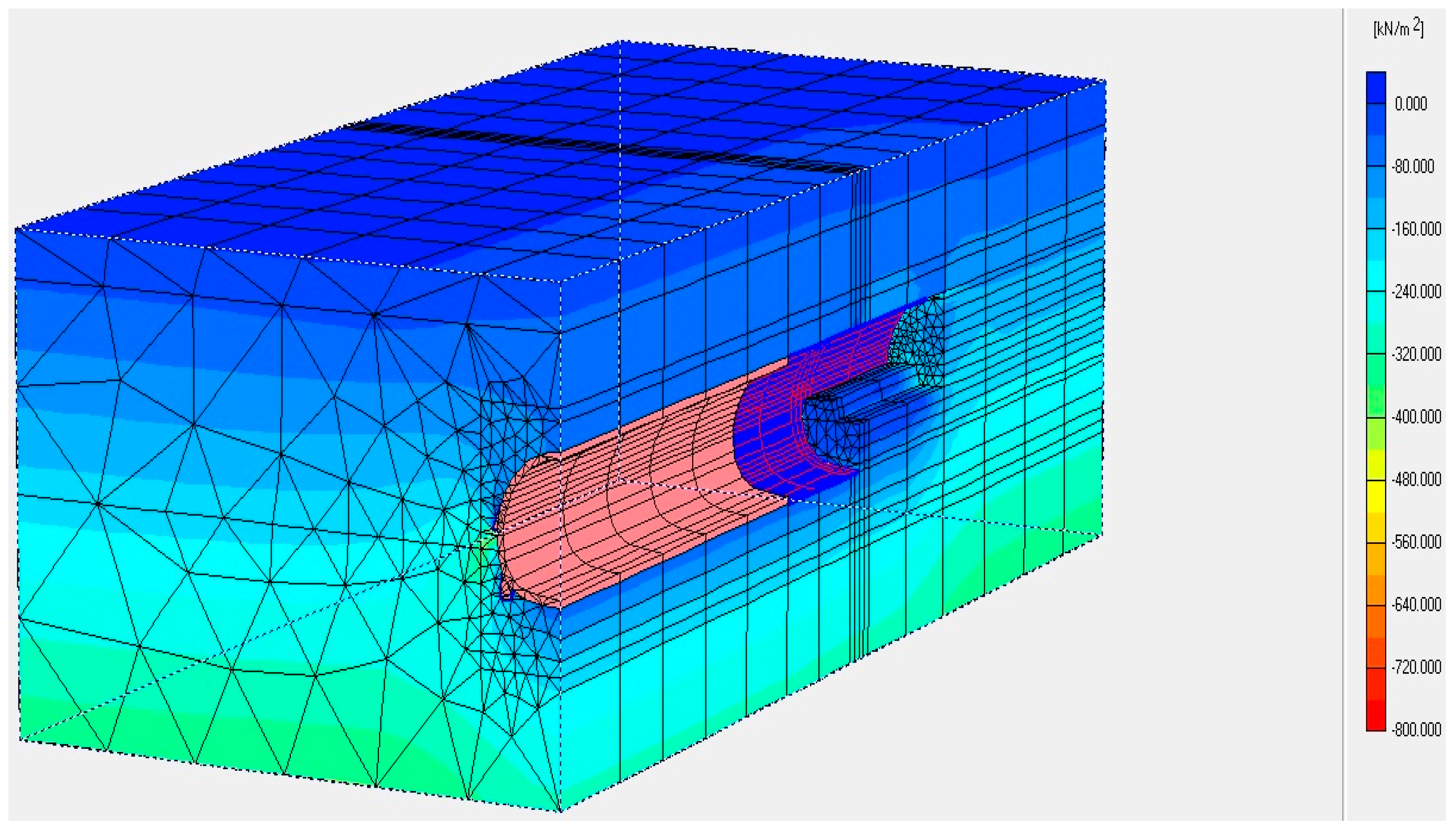
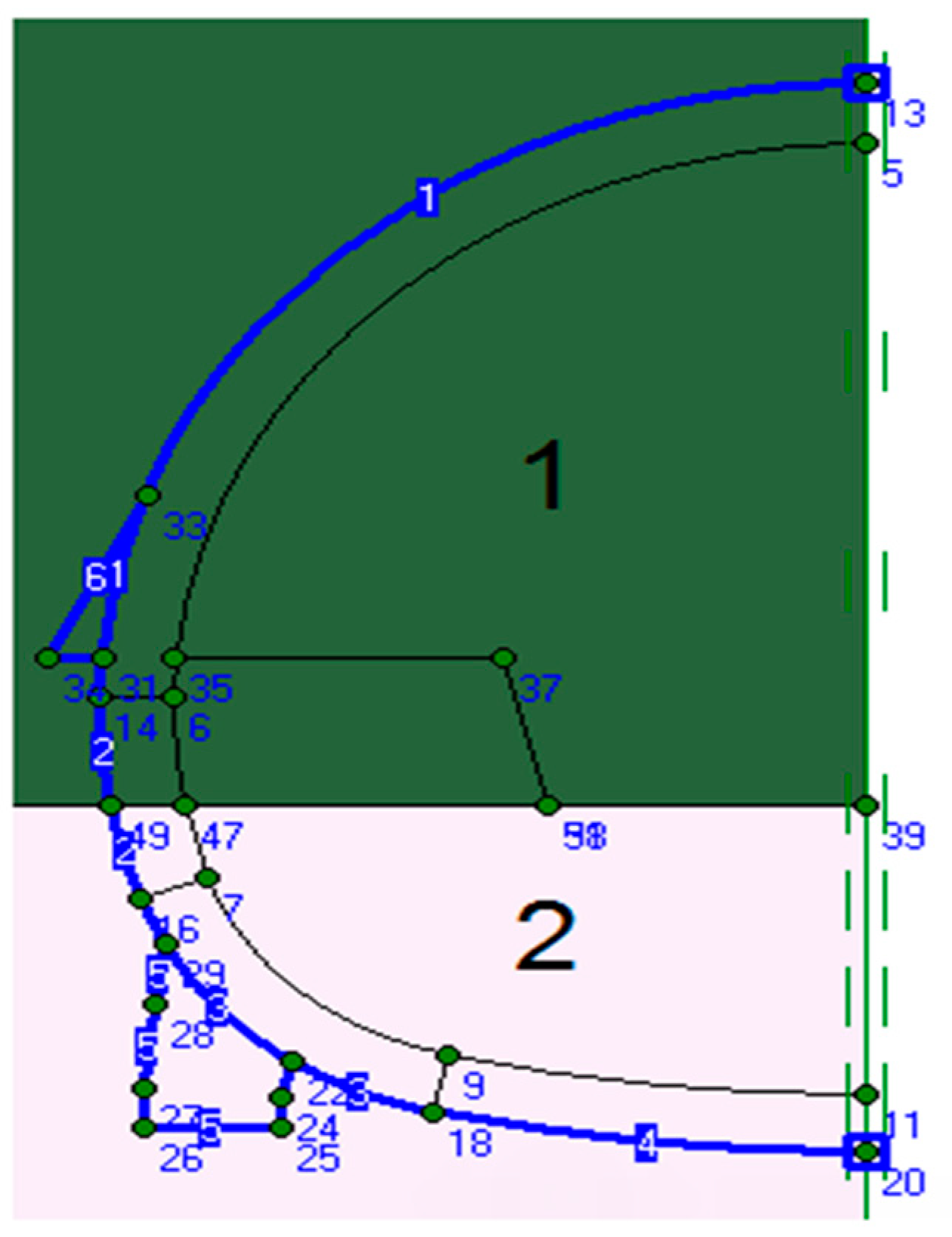


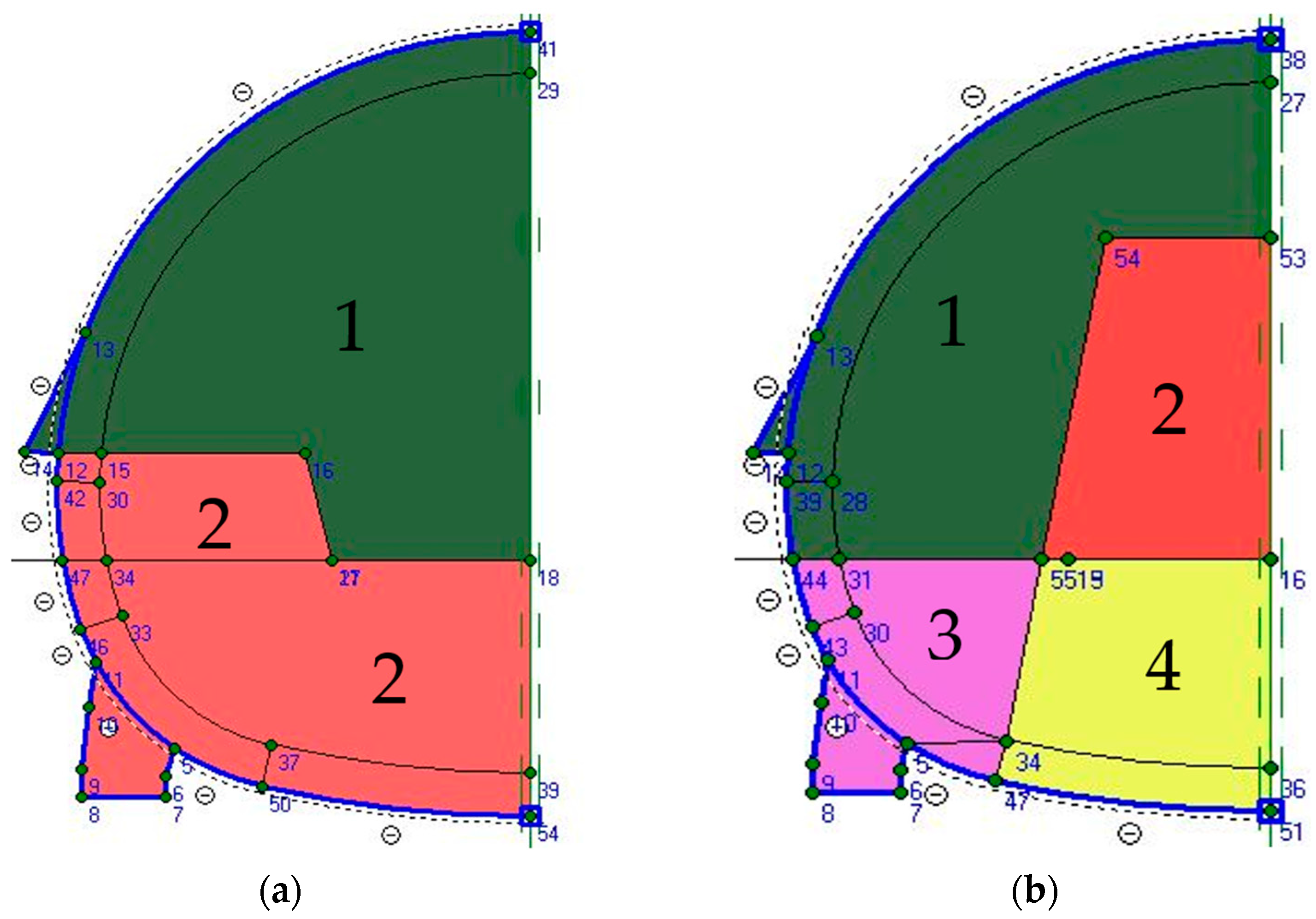
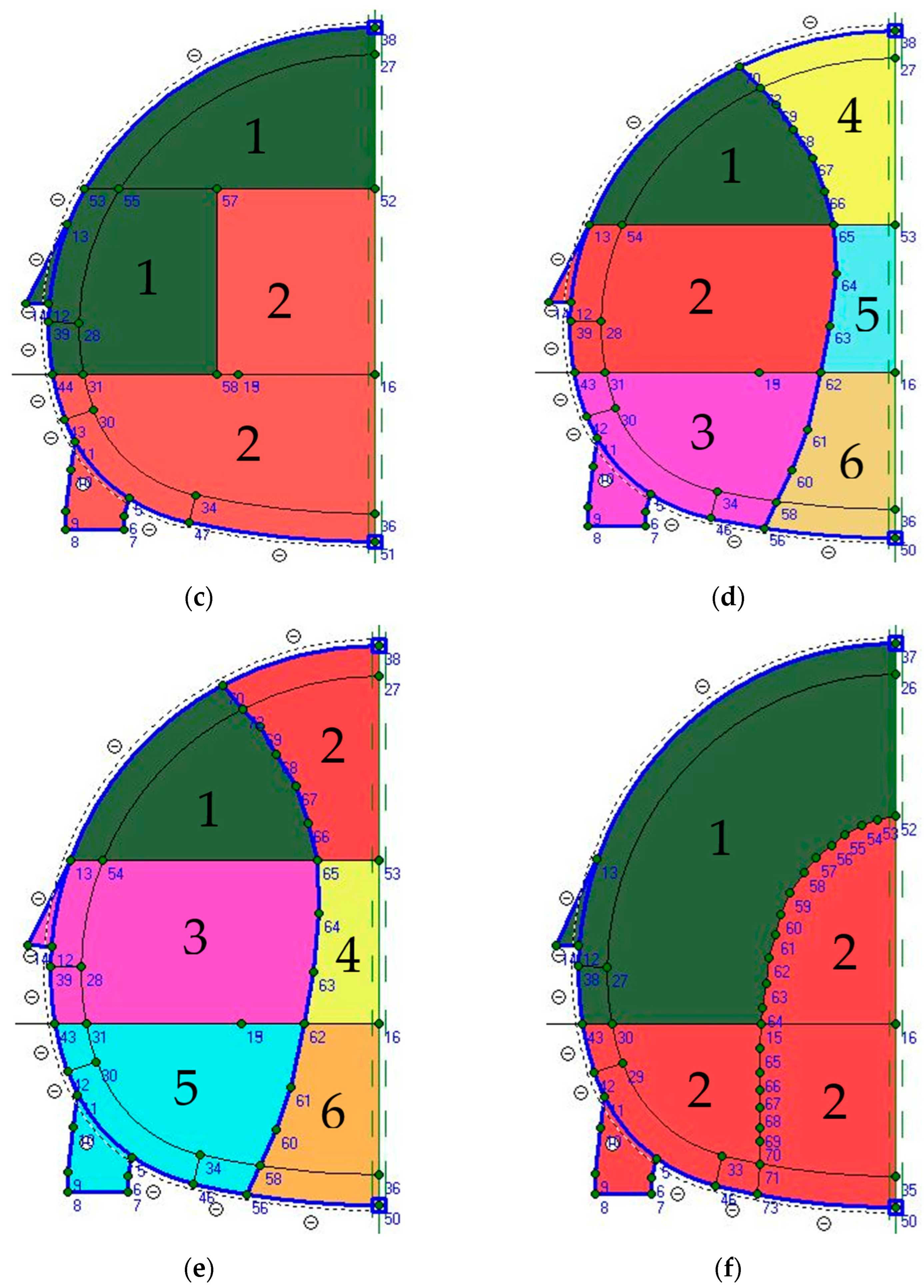


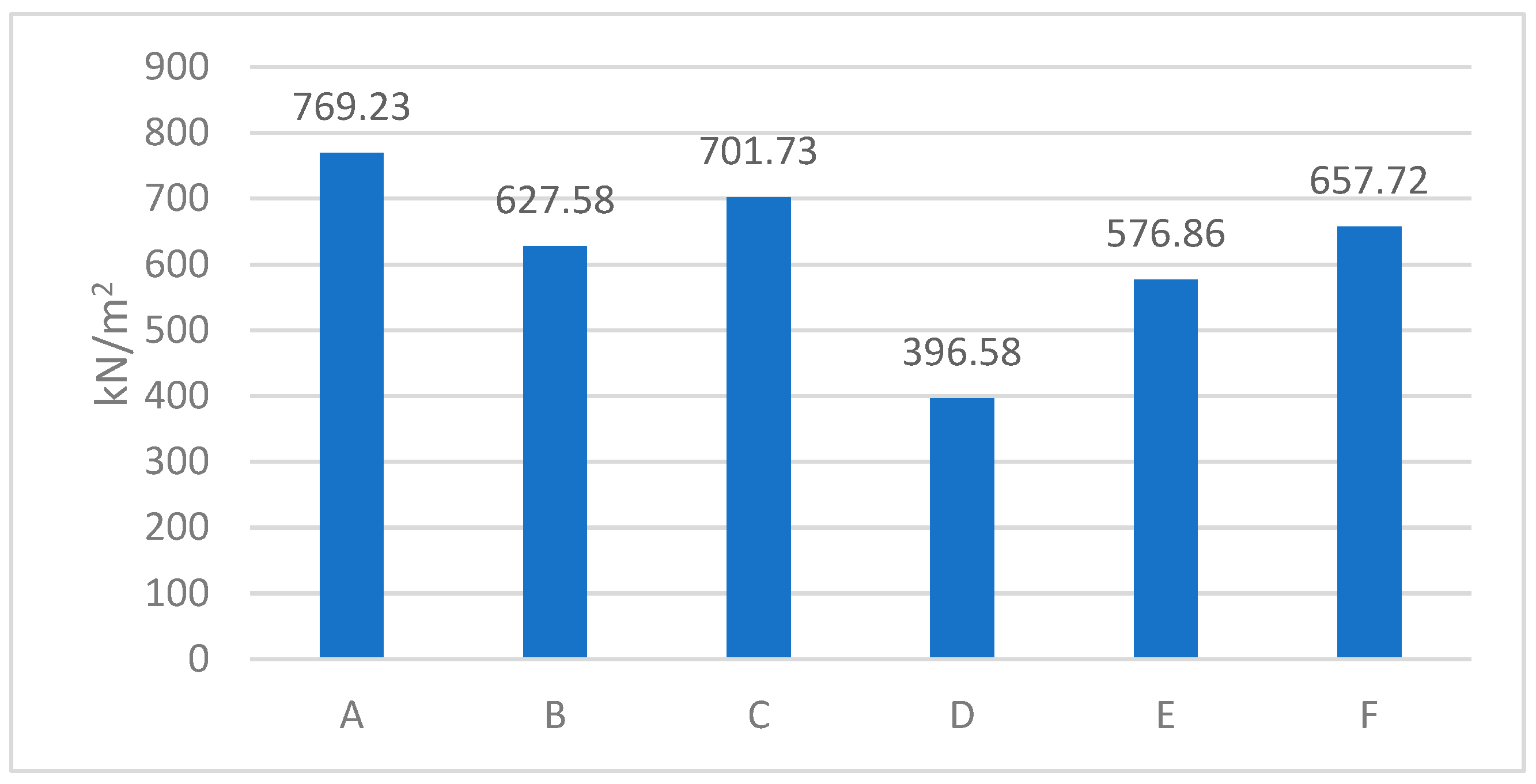
| Upper Layer (Sand) | Middle Layer (Clay with Silt) | Bottom Layer (Clay with Silt) | |
|---|---|---|---|
| E (kN/m2) | 1.75 × 104 | 3.75 × 104 | 5.5 × 104 |
| ȣunsat (kN/m3) | 16.9 | 16.9 | 16.9 |
| ȣsat (kN/m3) | 20,250 | 20,250 | 20,250 |
| ψ (°) | 0 | 0 | 0 |
| φ (°) | 27 | 27 | 27 |
| v | 0.35 | 0.35 | 0.35 |
| C (kN/m2) | 40 | 40 | 40 |
| K0 | 0.548 | 0.492 | 0.504 |
| E (kN/m2) | ȣunsat (kN/m3) | v | EA (kN/m) | EI (kNm2) | d (m) | W (kN) | |
|---|---|---|---|---|---|---|---|
| Shotcrete | − | − | 0.2 | 6.103 × 106 | 2.215 × 104 | 0.209 | 7.2 |
| Final concrete | 2.387 × 107 | 25 | 0.2 | − | − | − | − |
| Parameter | Definition |
|---|---|
| E | Elasticity module |
| ȣunsat | Unsaturated unit weight |
| ȣsat | Saturated unit weight |
| Ψ | Angle of dilation |
| Φ | Internal friction angle |
| V | Poisson’s ratio |
| C | Cohesion |
| K0 | Coefficient of lateral earth pressure |
| EA | Normal stiffness (axial rigidity) |
| EI | Flexural rigidity |
| d | Equivalent thickness |
| W | Unit weight |
Disclaimer/Publisher’s Note: The statements, opinions and data contained in all publications are solely those of the individual author(s) and contributor(s) and not of MDPI and/or the editor(s). MDPI and/or the editor(s) disclaim responsibility for any injury to people or property resulting from any ideas, methods, instructions or products referred to in the content. |
© 2024 by the authors. Licensee MDPI, Basel, Switzerland. This article is an open access article distributed under the terms and conditions of the Creative Commons Attribution (CC BY) license (https://creativecommons.org/licenses/by/4.0/).
Share and Cite
Dashti, M.; Virág, Z. Improved Subsidence Assessment for More Reliable Excavation Activity in Tehran. Appl. Sci. 2024, 14, 7547. https://doi.org/10.3390/app14177547
Dashti M, Virág Z. Improved Subsidence Assessment for More Reliable Excavation Activity in Tehran. Applied Sciences. 2024; 14(17):7547. https://doi.org/10.3390/app14177547
Chicago/Turabian StyleDashti, Mahdi, and Zoltán Virág. 2024. "Improved Subsidence Assessment for More Reliable Excavation Activity in Tehran" Applied Sciences 14, no. 17: 7547. https://doi.org/10.3390/app14177547





